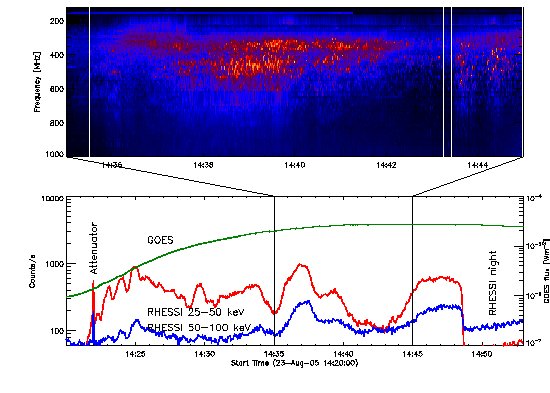Do solar decimetric spikes originate in coronal X-ray sources?
From RHESSI Wiki
Introduction
In the standard solar flare scenario, a large number of particles (electrons and protons) are accelerated in the solar corona. Radiative signatures of those particles are found in X-rays and radio wavelenghts, teling us the the particles are non-thermally distributed in energy. Assuming that the same distribution of particles causes both, X-ray and radio emission, one would expect a close relation of the two emission types. Indeed, millisecond spikes have been found to have a high temporal association rate with hard X-rays.
But what about the spatial relations? Sticking to the picture of a coronal acceleration site one would expect coronal X-ray emission and radio spikes to originate from the same positions.
Observations
By combining RHESSI observations (positions of X-ray sources) with Phoenix-2 data (identification of radio spikes) and observations from the Nancay Radio Heliograph (locations of the radio emission in 4 discrete frequencies) in a particularly well observed limb event we can find - at least one - answer to the above question. Figure one shows the radio spectrogram and the thermal and nonthermal X-ray light curves of the event. The spikes occured in the impulsive phase, when the soft X-ray emission was still rising. However, the radio emission is not clearly correlated with the details of the hard X-ray lightcurve.

 band produced by thermal emission.
band produced by thermal emission.Now let us have a look at the spatial relations.
Biographical Note: Arnold Benz is Professor at ETH Zurich, Switzerland. Marina Battaglia ist a post-doctoral research fellow at the University of Glasgow, Scotland.
